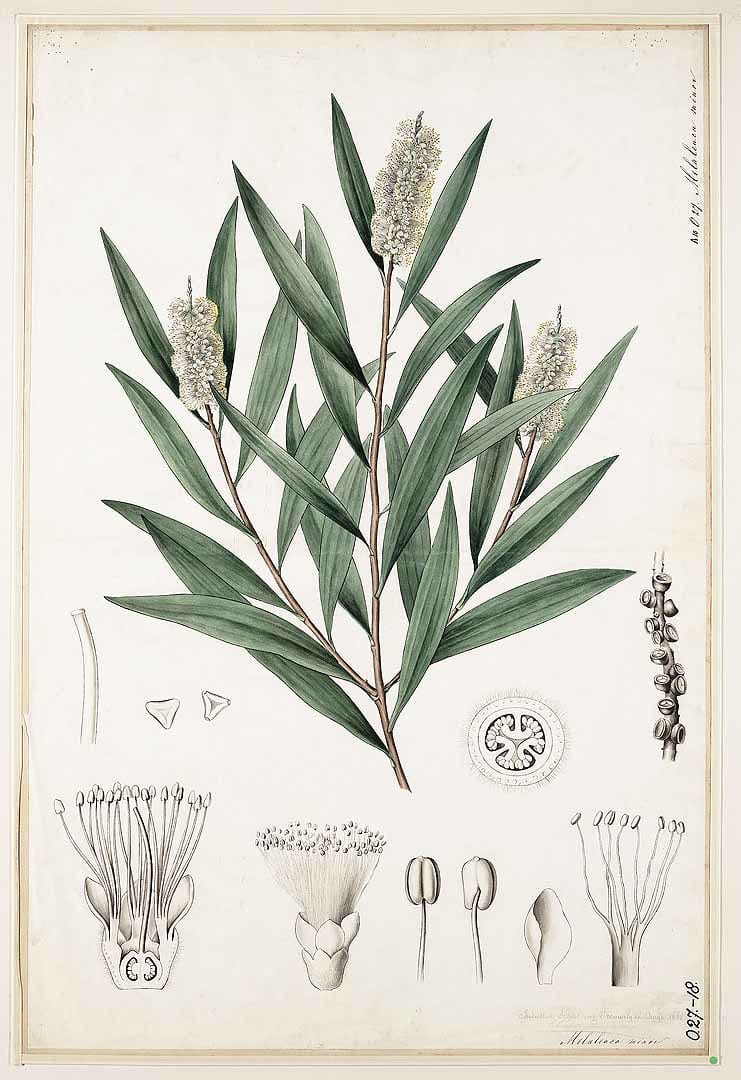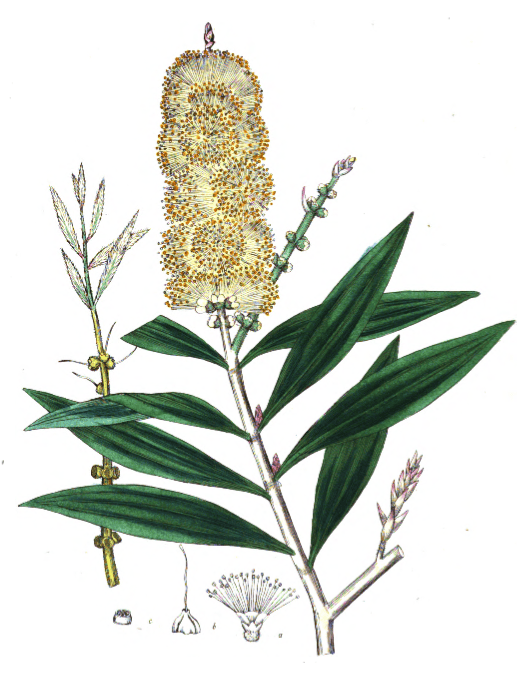Cajeput oilCajeput tree, Swamp Tea treeKayaputi (Ayurveda) |

|
 Botanische wandplaten (1904–1914)
Botanische wandplaten (1904–1914) Medical Botany, Hooker, Vol V, 1832
Medical Botany, Hooker, Vol V, 1832Botanical name:
Melaleuca leucadendron (syn M. cajuputi)
Parts used:
OIl
Temperature & Taste:
Warm, dry. Pungent, aromatic
Uses:
1. Clears Wind-Cold, Promotes Sweat:
-Cold, Flu with fever
-wind-damp pain
-Intermittent Fever
-skin diseases with itching
2. Moves Qi:
-Stomach pain, Colic
-promotes Menstruation
-Hysteria
3. Clears Phlegm, Stops Cough:
-expectorant in chronic laryngitis, Bronchitis
4. Clears Damp, Promotes Urine:
-has been used for Edema, fluid retention
-Chronic Rheumatism, Arthritic complaints
-Cystitis
5. Kills Worms:
-especially Roundworm
6. Externally:
-ointments and oils for neuralgia, rheumatism, stiffness, sprains and strains
-cold, influenza
-Headache, Migraine
-Mosquito repellent
-topically to toothache
-topical antibacterial
-topically to Eczema, Psoriasis
Dose:
Of the Oil: 2–12 drops on sugar
Topically diluted with oil (such as olive), or made into an ointment with Wax and Oil or Suet.
Substitutes:
Schoenanthus is used similarly and was used as a substitute.
Main Combinations:
1. To promote Menstruation, Cajeput oil made into pills with Galbanum, Asafetida, Myrrh
2. Epilepsy, Cajeput oil with Valerian, Orange peel
3. Pain, Neuralgia:
i. topically Cajeput oil with Oil of Bay berry, Spirit of Turpentine mixed with Suet
4. Nervous and Paralytic conditions, Cajeput oil, Rosemary oil, Mint oil, Camomile oil
5. Spasms: Valerian root, Orange leaf, Cajeput oil
6. Toothache, Cajeput oil with Clove oil
Cautions:
1. Use cautiously internally and avoid overodse
2. Not used internally during pregnancy
Main Preparations used:
Essential Oil
- Extra Info
-
History
|
‘Rumphius, who passed nearly fifty years in the Dutch possessions in the East Indies and died at Amboyna in 1702, is the first to give an account of the oil under notice, and of the tree from which it is obtained. From what he says, it appears that the aromatic properties of the tree are well known to the Malays and Javanese, who were in the habit of steeping its leaves in oil which they then impregnated with the smoke of benzoin and other arornatics, so obtaining an odorous liquid for anointing their heads. They likewise used cushions stuffed with the leaves, and also laid the latter in chests to keep away insects. The fragrance of the foliage having thus attracted the attention of the Dutch, probably suggested submitting the leaves to distillation. Rumphius narrates how the oil was obtained in very small quantities, and was regarded as a powerful sudorific‘ In Europe it appears to have been first noticed by J. M. Lochner, |
of Nurnberg, physician to the German Emperor. About the same time (1717), a ship’s surgeon, returning from the east, sold a provision of the oil to the distinguished apothecary Johann Heinrich Link at Leipzig, who published a notice on it and sold it. It began then to be quoted in the tariffs of other German apothecaries, although it was still reputed a very rare article in 1726. Somewhat larger quantities appear to have been soon imported by Amsterdam druggists. In Germany the oil took the name of Oleum Wittnebianum, from the recommendations bestowed on it by M. von Wittneben, of Wolfenbiittel, who was much engaged in natural sciences and long resident in Batavia. In France and England, it was however scarcely known till the commencement of the present century, though it had a place in the Edinburgh Pharmacopoeia of 1788. In the London Price Current, we do not find it quoted earlier than 1813, when the price given is 3s. to 3s. 6d. per ounce, with a duty of 2s. 4 ½ d. per ounce’. (Pharmacographia, Fluckiger & Hanbury, 1879) |
